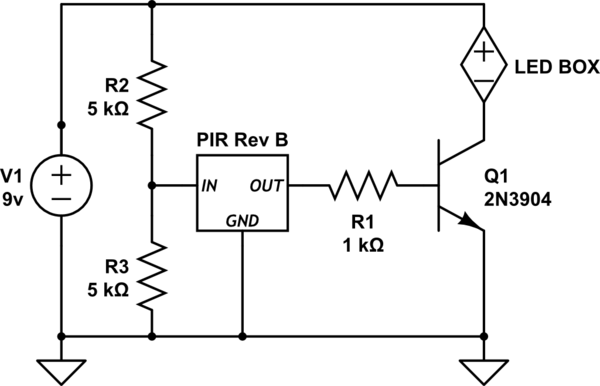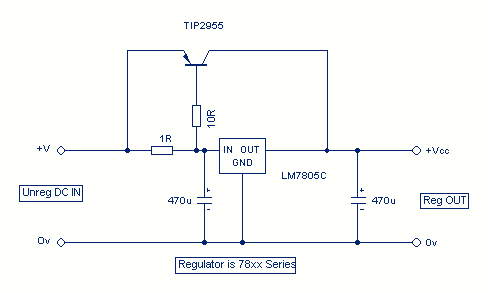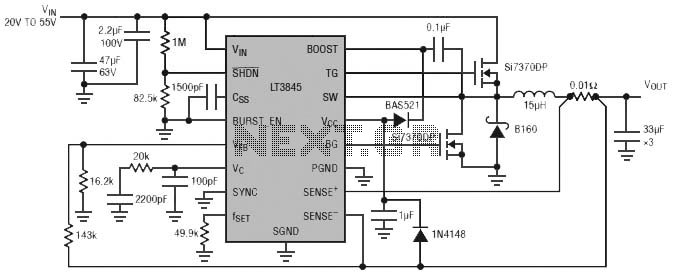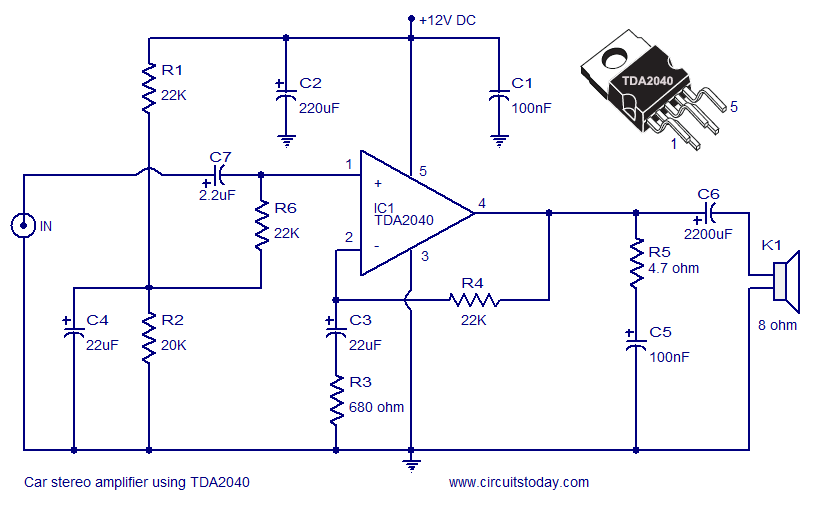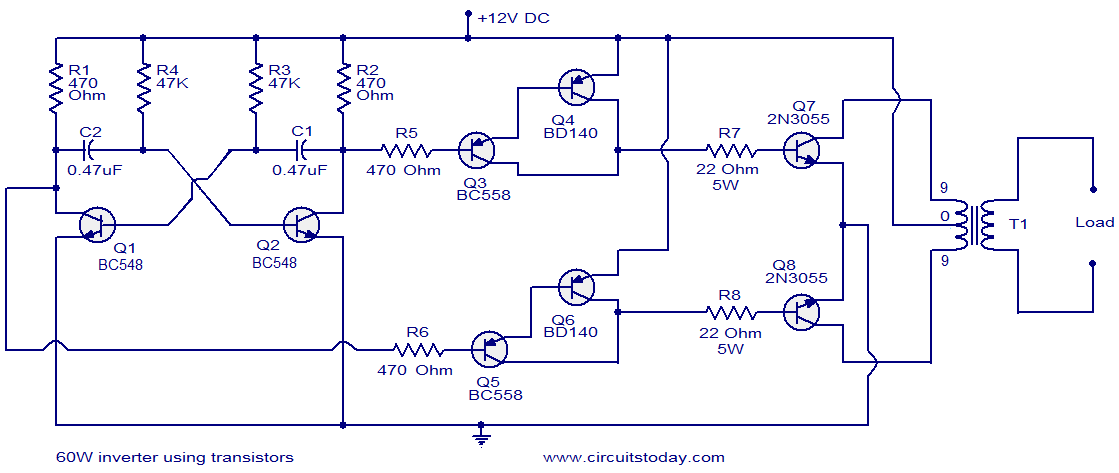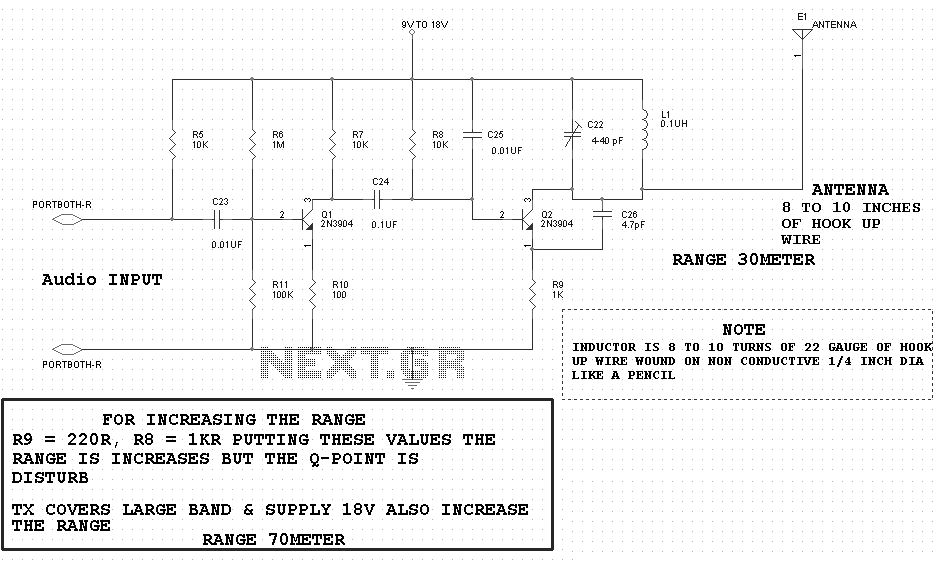
5 volts high current power supply using 7805 voltage regulator
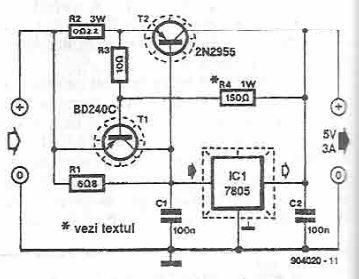
This power supply circuit is designed to provide a high current 5-volt output using a 7805 voltage regulator along with several standard electronic components. The transistor T1 functions as a current limiter. When the voltage across resistors R2 and R3 exceeds 0.6 to 0.7 volts, the transistor activates, which results in the current to the base of transistor T2 being reduced to zero. The protective circuit's operation is determined by the combined voltage drops across R2 and R3. Resistors R3 and R4 create a voltage divider for T2.
This power supply circuit utilizes a 7805 voltage regulator, which is a popular choice for providing regulated 5V output. The 7805 requires an input voltage that is typically higher than 7V to ensure proper regulation. The circuit's design incorporates T1 as a current limiting device to protect against excessive current draw. When the voltage across R2 and R3 reaches the threshold of 0.6 to 0.7 volts, T1 switches on, effectively cutting off the base current to T2. This action prevents T2 from turning on, which would otherwise allow more current to flow through the circuit.
The arrangement of resistors R2 and R3 is critical, as they are responsible for monitoring the voltage levels and ensuring that the current remains within safe limits. The voltage divider formed by resistors R3 and R4 is essential for establishing the correct biasing conditions for T2, allowing it to function properly within the circuit. This configuration ensures that T2 only activates when the voltage levels indicate that it is safe to do so, thus providing an additional layer of protection for the entire power supply circuit.
Overall, this circuit is an efficient solution for applications requiring a stable 5V power supply with built-in current limiting features, making it suitable for various electronic devices and projects.This power supply electronic circuit is a high current 5 volts power supply circuit that use a 7805 voltage regulator and some classic electronic components. T1 acts as a current limiter. Once the voltage on R2 + R3 is greater than 0. 6 0. 7 V, the transistor opens, which will reduce to zero the current in the base of T2. Voltage from which enters i n operation the protective circuit is given by the sum of drops voltage on the R2 and R3. Resistors R3 and R4 form a voltage divider on T2. 🔗 External reference
This power supply circuit utilizes a 7805 voltage regulator, which is a popular choice for providing regulated 5V output. The 7805 requires an input voltage that is typically higher than 7V to ensure proper regulation. The circuit's design incorporates T1 as a current limiting device to protect against excessive current draw. When the voltage across R2 and R3 reaches the threshold of 0.6 to 0.7 volts, T1 switches on, effectively cutting off the base current to T2. This action prevents T2 from turning on, which would otherwise allow more current to flow through the circuit.
The arrangement of resistors R2 and R3 is critical, as they are responsible for monitoring the voltage levels and ensuring that the current remains within safe limits. The voltage divider formed by resistors R3 and R4 is essential for establishing the correct biasing conditions for T2, allowing it to function properly within the circuit. This configuration ensures that T2 only activates when the voltage levels indicate that it is safe to do so, thus providing an additional layer of protection for the entire power supply circuit.
Overall, this circuit is an efficient solution for applications requiring a stable 5V power supply with built-in current limiting features, making it suitable for various electronic devices and projects.This power supply electronic circuit is a high current 5 volts power supply circuit that use a 7805 voltage regulator and some classic electronic components. T1 acts as a current limiter. Once the voltage on R2 + R3 is greater than 0. 6 0. 7 V, the transistor opens, which will reduce to zero the current in the base of T2. Voltage from which enters i n operation the protective circuit is given by the sum of drops voltage on the R2 and R3. Resistors R3 and R4 form a voltage divider on T2. 🔗 External reference
